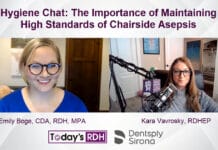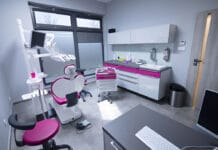It takes years of trial and error for a dental hygienist to assemble the perfect arsenal of supplies, equipment, and techniques which allow him or her to provide the best care possible, in the best manner possible. Even the most seasoned hygienist will relentlessly search reviews, exhibit halls, and dental catalogs for that one thing that will undeniably transform her professional life. Sound like you?! Read on to discover the Top 10 Essentials for Every Hygienists’ Toolkit.
Loupes + Headlight
Few dental hygiene education programs surprisingly still do not require their students to wear loupes, while on the other hand, some programs encourage students to utilize not only loupes but sometimes even a headlight as well. The combination of magnification plus light encourages better ergonomics and allows for a more efficient appointment. No more wasted time adjusting the overhead light for every tooth! No more leaning over to get a closer look at the distal of the molars! No more bumping your head on the overhead light when you stand up! Utilizing loupes and a headlight is easily the best decision a hygienist can make for themselves.
SE Cushion Saliva Ejector Foam Tips
Favorite tools don’t necessarily have to cost an arm and a leg. Meet the SE cushion saliva ejector foam tip. Sometimes white or sometimes blue, these small, but comforting, cushions are placed at the tip of the saliva ejector and prevent tissue-grabbing and irritation. These are a must-use item while applying sealants, polishing, or using an ultrasonic scaler. As a bonus, these tiny pillows of goodness also prevent the ungodly, high-pitched screeching that often occurs when tissue partially clogs the suction.
Silver Diamine Fluoride
New to American dentistry, Silver Diamine Fluoride (SDF) is one of the most valuable tools a hygienist has available to them. In 2014, SDF was cleared by the FDA for use as a desensitizing agent. However, the off-label use as a caries-arresting agent is of even more significance. It takes mere seconds to apply, is simple to use, and is one of the only proven things that attack the caries disease process at the microbial level. This is easily one of the greatest gifts a hygienist can give their patients
Wet-bond Sealant Technology
Not all sealant material is created equal. The variety of sealant material available in a typical supply catalog can be overwhelming at times, but sealants that utilize wet-bond technology stand head and shoulders above the rest. Instead of applying a sealant to a bone-dry surface, wet-bond technology must be applied to a damp surface. This is clearly advantageous when applying sealants to young children, patients with disabilities, and when working without an assistant.
Left and Right Ultrasonic Inserts
Left and right ultrasonic inserts are often a necessary part of every hygiene student’s toolkit but are seldom seen once entering clinical practice. Do yourself a favor, reach way down into your forgotten pile of hygiene school supplies and dig out those area-specific inserts you’ve totally forgotten about. You will not be disappointed! It may take some time to find a new rhythm, but these magical instruments will not let you down. The curved tips work wonders around line angles, adapt deeply into furcations and anomalies, and thanks to the slim design, help improve tactile sensation.
Tray Cover + Charting
It is the simple things in a hygienist’s professional life that mean the most. Though somewhat uncommon, tray covers that include chart templates have been helping hygienists for years. Is no one available to help you record periodontal measurements? Did you find a hidden spot of decay while scaling under the margin of a crown? Simply jot it down on your tray cover and add it to your clinical notes later.
Saddle Seating
Now gaining in popularity, saddle seating is another great way to create a safer work environment for the clinician. Saddles allow the hygienist to be in a sit/stand position and maintain a proper S-curve posture in the lumbar region. Some of the many benefits include deeper breathing, improved leg circulation, and a more stable reach.
Right and Left Fitted Gloves
Do you have consistent and inexplicable pain at the base of your thumb? Did you know it could be due to the use of ambidextrous gloves? Ambidextrous gloves put unnatural pressure on the thumb and were originally created to be worn for quick procedures, like exams. Right and left fitted gloves maintain the thumb’s natural and more neutral position and are ideal for use during long procedures.
Custom-made Earplugs
How many of your dental colleagues wear hearing aids? How many complain of ringing in their ears? How many insist on watching movies with the subtitles on? Unfortunately, a dental hygienist wearing ear protection is a rare thing. Because there is never a quiet moment in the dental office thanks to noisy handpieces, ultrasonic scalers and cleaner units, and suction, hearing loss seems almost inevitable. While over-the-counter earplugs do offer some protection, they also do not permit acceptable decibel ranges, such as hearing a patient’s voice. The good news is that an audiologist can provide custom-made earplugs, such as the DI-15, that protect you from potentially damaging sounds while allowing for normal conversation.
A Healthy Work Environment
What truly tops the list of essential hygiene tools is simply having a work environment comprised of an employer and colleagues filled with support, respect, and who function with a team mentality. Even though a healthy work environment is the most important here, for many hygienists, it can sometimes be difficult to find. Bitterness, anger, and other effects of an unhealthy workplace easily creep into and significantly affect personal lives. A healthy work environment is critical to the well-being of hygienists everywhere.
Tools which create practice efficiency, and that allow better ergonomics, are indispensable whether you are a new grad or a seasoned hygienist. So, what are you waiting for?
SEE ALSO: Advice for the Newly Graduated Dental Hygienist
DON’T MISS: Social Media Dos and Don’ts for the Dental Professional











